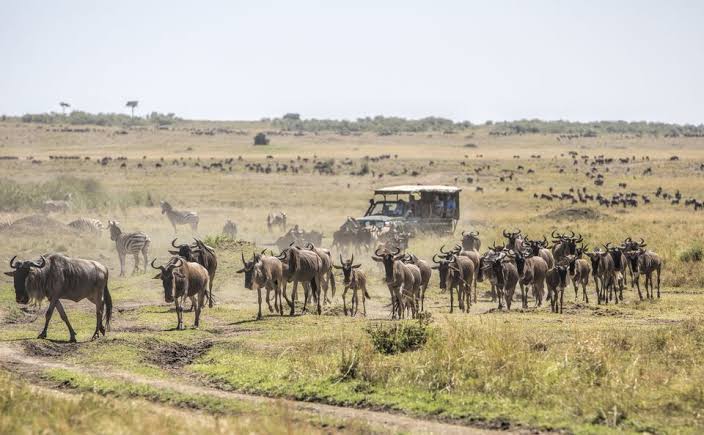Best Self Drive Gide to Masai Mara National Reserve
Masai Mara National Reserve is one of Kenya’s premier national parks, alongside Amboseli National Park and Lake Nakuru National Park. The reserve is renowned not only in Kenya but globally. The reserve is located in the Great Rift Valley region, near to the formidable Serengeti National Park in Tanzania, constituting the expansive Mara-Serengeti Ecosystem. The national reserve was designated in tribute to the indigenous Maasai people of the region. The reserve was named Mara, signifying the “spotted circles of trees.” The reserve features wide savannah grassland interspersed with scrub and Acacia trees.
The Masai Mara National Reserve was established in 1961 as a wildlife sanctuary to save giant felines and other fauna from poaching. The sanctuary encompassed a modest size of 520 square kilometers. The pilot study sanctuary was located in the central region of the existing reserve, which encompasses the current Mara Triangle. Following several months of significant accomplishments, the sanctuary was extended eastward, now including a total area of 1,821 square kilometers. Following the sanctuary’s expansion, the local community, in conjunction with the Kenyan Government, designated the area as a National Reserve, subsequently dubbing it the Masai Mara National Reserve.
The recently established game reserve was managed by the local community of Narok County Councils. In 1974, the Masai Mara National Reserve was officially designated as a national reserve. In response to the population growth, the local council consented to restore 159 square kilometers of land to the residents. In 1976, the Masai Mara experienced a further decline in acreage, and by 1984, the reserve encompassed a total of 1,510 square kilometers.
Following the establishment of the new council in the region that seceded from Narok County, the leaders concurred to create a new entity that administers the Masai Mara National Reserve. The Trans Mara County Council was established to facilitate the administration of the reserve between the two governments that encompass it. In 2001, Mara Conservancy was established to enhance the management and safeguarding of the reserve with the active participation of the local population.
The elephant population is consistently expanding year just in the Masai Mara National Reserve. The park is home to all of the African Big Five: elephants, buffalo, lions, leopards, and rhinoceroses. The reserve adjoins the Siria escarpment to the west, Serengeti National Park to the south, and numerous Maasai pastoral ranches to the west, east, and north. The Reserve is supplied by the Masai Mara River, which is the primary water source, along with the Talek River. The great wildebeest migration occurs along these two rivers. The natives refer to the Mara River as the gateway through which wildebeest traverse to access the Masai Mara National Reserve from Serengeti National Park. The Talek River serves as the egress point for the wildebeest migration as it departs the Masai Mara National Reserve and reenters Serengeti National Park.
The Masai Mara National Reserve is renowned for the largest annual wildlife migration on the planet. The wildebeest migration occurs along the Mara River, when millions of wildebeest traverse to and from Serengeti National Park. The reserve is home to many wildlife, including Nile crocodiles, gazelles, dik-dik, olive baboons, zebras, kudu, giraffes, and numerous others.
The Masai Mara National Reserve comprises the Mara Ecosystem, which includes regions such as the Mara Triangle and conservancies including Koiyaki, Ol Chorro Oirowau, Lemek, Siana, Olkinyei, Oloiren, Naikara, Kimintet, Kerinkani, and Maji Moto.
Geographical location of Masai Mara National Reserve
The Masai Mara National Reserve is situated in the southwest of the city, Nairobi. The journey from Nairobi traversing the Maasai local settlements and towns requires 5 to 6 hours of driving. The distance from Nairobi to Masai Mara is 224 kilometers, equivalent to 139.2 miles. The drive is highly picturesque along the Great Rift Valley, showcasing the characteristics of volcanic activity. The condition of the roads remains satisfactory until Narok town; beyond this point, the road quality deteriorates, necessitating the use of 4×4 vehicles instead of 2×2 wheel drive cars. The driving experience during the rainy season is peculiar, particularly within the park.
The park can be accessed by air via several domestic flights servicing all the airstrips inside the reserve. The flight duration from Nairobi Wilson Airport to various airstrips, including Kichwa Tembo and Mara Serena, is 45 minutes. Numerous domestic airlines, including as Safarilink, conduct daily flights to Masai Mara.

Attractions for safari in Masai Mara
Masai Mara National Reserve is among the most renowned reserves in Kenya. Wildlife observation is exceptional and can be conducted year-round. The lush flora and year-round drainage by the Mara River bring numerous herbivores to the reserve, so fostering a conducive environment for predators.
Maasai Tribe:
The Maasai are a remarkable tribe whose culture has remained unchanged for centuries. Despite the inhabitants’ exposure to various modern cultures through interactions with diverse tourists worldwide, they have stayed steadfast in their cultural traditions. The authentic African experience is ascribed to the indigenous Maasai community. Nevertheless, while the world is advancing in modernization, the Maasi people are content with traditional way of life. These are the local pastoralists who have successfully coexisted with animals in various protected zones across Africa. While planning your exploration of Africa, you will encounter the Maasai people on your visit to the esteemed Masai Mara National Reserve.
Fauna in Masai Mara National Reserve:
The renowned reserve is inhabited by remarkable species such as wildebeests, cheetahs, hyenas, giraffes, jackals, zebras, and gazelles, among others. The reserve is home to the African Big Five: Lions, Leopards, Elephants, Buffalo, and Rhinos. The reserve is home to migratory species that arrive from the neighboring Serengeti National Park between July and October.
Migration of wildebeest:
The world’s largest wildlife migration, regarded as one of Africa’s natural wonders, occurs in the Masai Mara National Reserve. The wildebeest migrations occur yearly in July, when millions of wildebeest traverse the Mara River from Serengeti National Park to Masai Mara. The migration period is dictated by the climatic conditions or precipitation patterns of the year. This is a primary attraction that draws thousands of visitors to Masai Mara National Reserve in July. In October, the wildebeest migrate back to Serengeti National Park.
Birds:
The Masai Mara is home to around 450 bird species, including 45 kinds of raptors. The largest bird, popularly referred to as the Masai Ostrich, was named after the reserve because of the significant population of these birds within it. The reserve’s diverse ecosystems have fostered a variety of bird species.
The reserve set a birding record by observing 342 bird species during a single-day safari. The reserve received a certificate of award from Birding Safaris. It accommodates a greater number of migrating birds that arrive from October to February, particularly Palearctic migrants, including terns, swallows, waders, and others. The avian checklist is extensive: Long-tailed Cormorant, Little Bittern, Cattle Egret, Rufous-billed Heron, Great Egret, Grey Heron, Hamerkop, Marabou Stork, Yellow-billed Stork, Hadeda Ibis, Sacred Ibis, Rüppell’s Vulture, Egyptian Vulture, African Fish Eagle, Tawny Eagle, Kori Bustard, Secretary Bird, Sooty Chat, Usambiro Barbet, Ostrich, and Lovebirds, among others.
Engagements in Masai Mara National Reserve
Hot Air Balloon Expeditions:
Hot air balloon safaris in the Masai Mara National Reserve offer a unique, once-in-a-lifetime experience that should not be overlooked. This occurs at a heightened level during the wildebeest migration, capturing the moment when the wildebeest across the Mara River. To maintain vigilant observation over the expansive dotted open savannah grassland. Experience unparalleled wildlife encounters in Masai Mara National Reserve with our balloon safaris. The hot air balloon safaris commence early in the morning with a briefing before to our ascent into the sky for a brief adventure. Soar through the atmosphere in a balloon with your loved ones while appreciating the picturesque landscapes and wildlife activities for a duration of 2 to 3 hours, contingent upon the day’s weather conditions. After the floating individual has a toast with a wine glass to complete your bush experience.
Safari excursions:
Game drives in Masai Mara National Reserve occur year-round using safari land cruisers or vans equipped with open roofs. All game drives utilize 4×4 vehicles capable of navigating the rough and muddy terrain of the reserve, particularly during the rainy season. Game drives occur early in the morning and later in the afternoon following lunch. Approach the wildlife at dawn as we witness the sunrise over the broad grassland in the reserve. We observe the creatures in their natural environment, where the large cats actively pursue their prey. Additional creatures for observation include zebras, wildebeests, elephants, hyenas, lions, and leopards. Rhinoceroses. Topi, kudu, and giraffes, among others. The game drives occur along the Mara or Talek River, where there is a significant concentration of species.
Bird watching:
Birding excursions provide the most gratifying safari experience in the Masai Mara National Reserve. This little open game reserve is home to over 450 bird species, allowing for an extensive checklist to be compiled in a brief timeframe. The reserve hosts 45 species of raptors, which inhabit the open savannah, rocky slopes, and riverbanks. Birds may be easily located as their habitats are distinctly marked by the prevailing ecosystem. The most frequently observed avian species include Rüppell’s Vulture, Egyptian Vulture, African Fish Eagle, Tawny Eagle, Kori Bustard, Secretary Bird, Sooty Chat, Usambiro Barbet, Ostrich, Lovebirds, Long-tailed Cormorant, Little Bittern, Cattle Egret, Rufous-billed Heron, Great Egret, Grey Heron, Hamerkop, and Marabou Stork, among others.
Maasai Cultural Excursion:
The cultural tour is a reinterpretation of our African experience, featuring a visit to the Maasai tribe. These represent the sole authentic African cultures that have remained unaltered by global civilization. The reserve is encircled by Maasai settlements where visitors can immerse themselves in the culture, including traditional jumping dances, hut construction, and various other activities.
The Masai Mara National Reserve is renowned for its compact size as a habitat for diverse fauna and avifauna. Observing the African Big Five is nearly assured, with cheetahs frequently perched atop the anthills. Do not miss the world’s greatest animal migration, the wildebeest migration in the Masai Mara National Reserve, which occurs from July to October.
